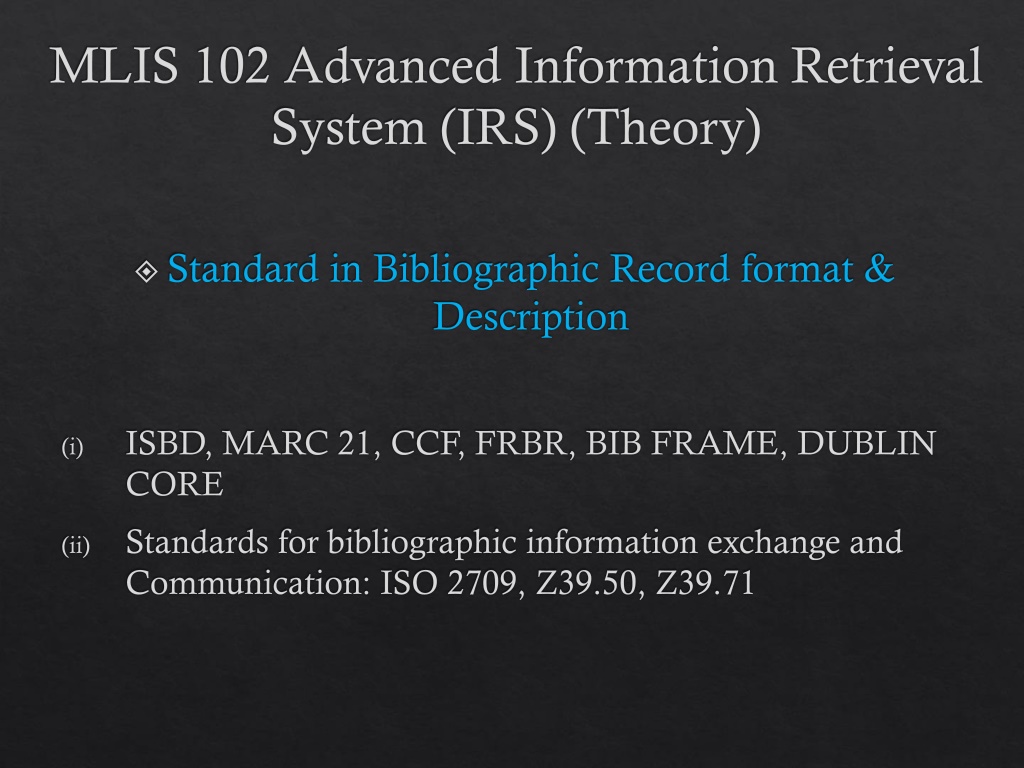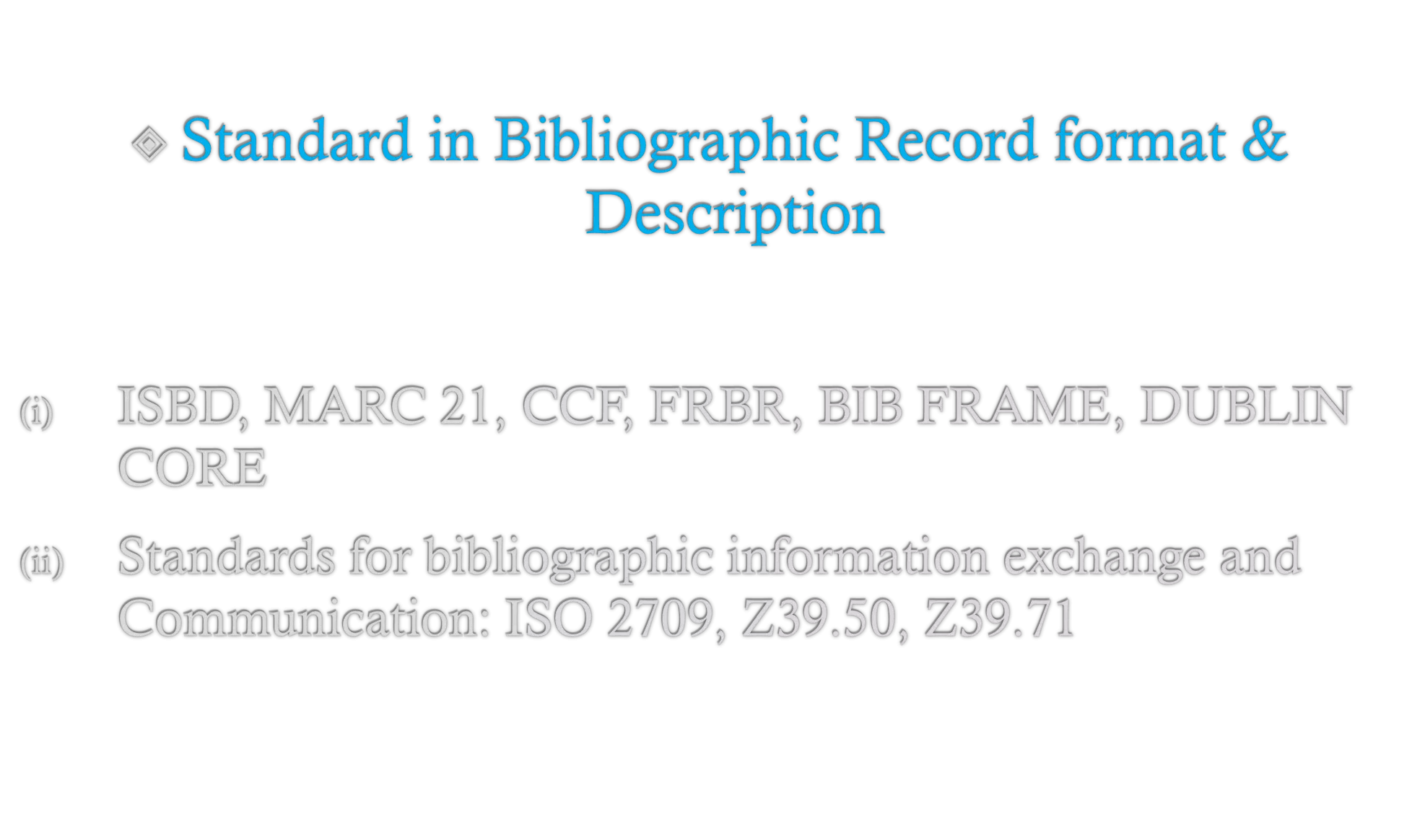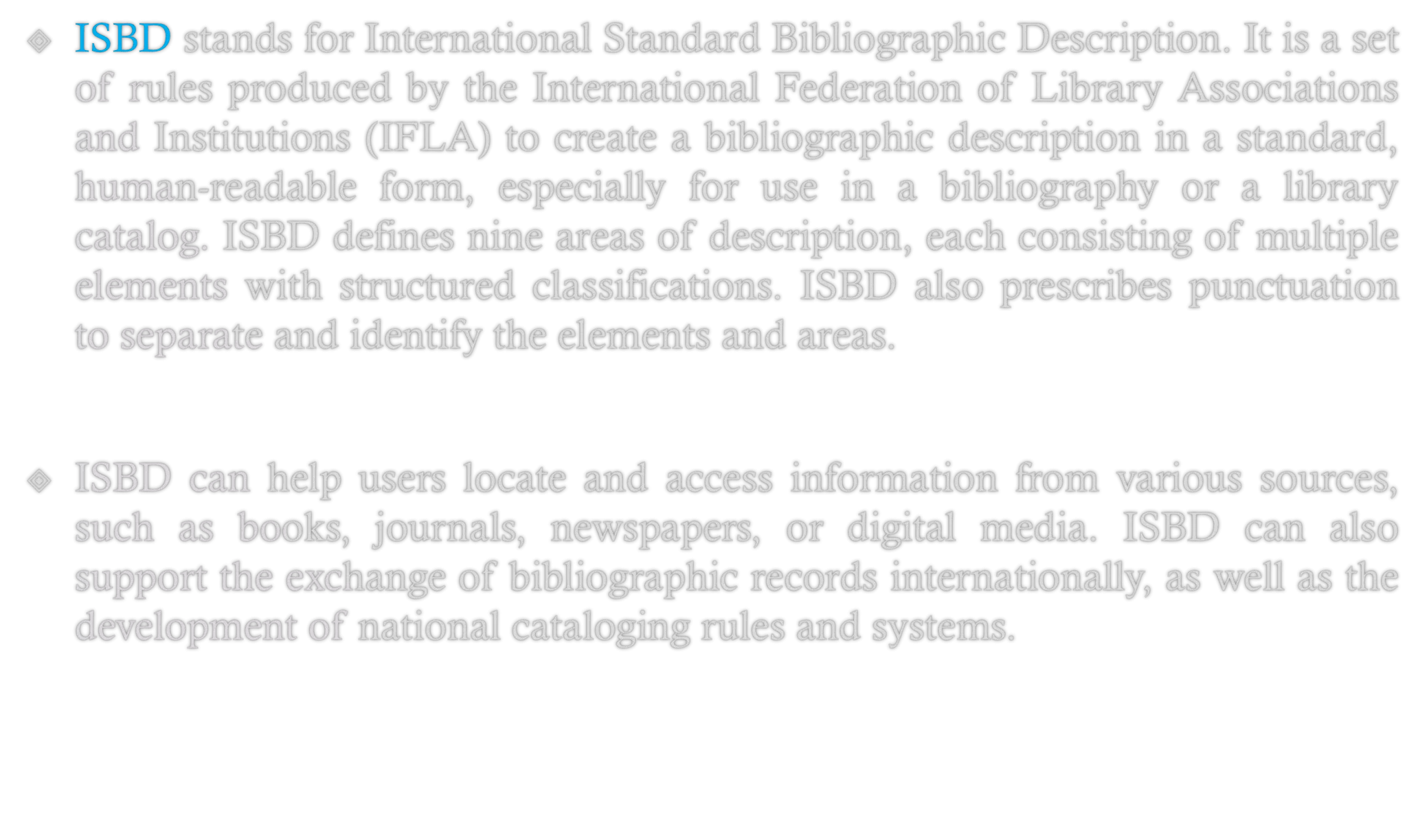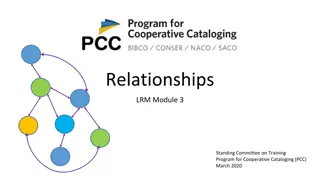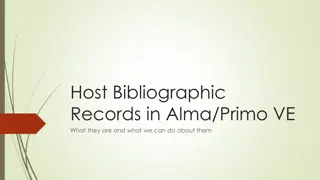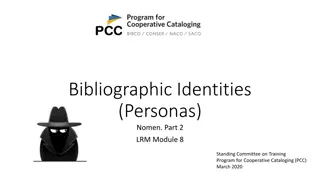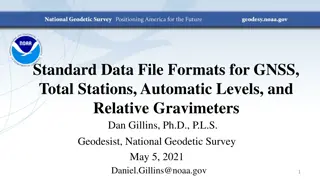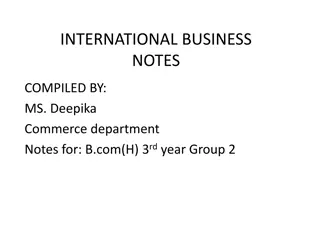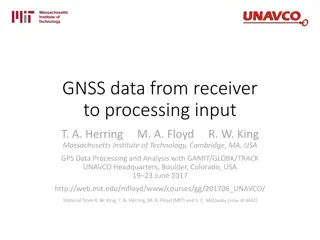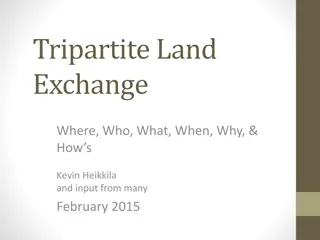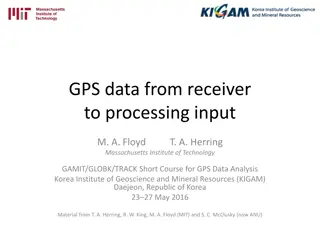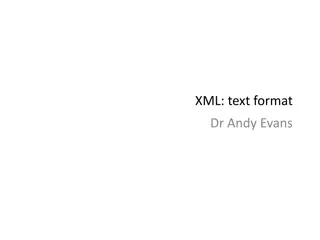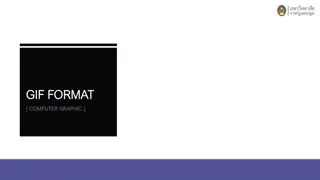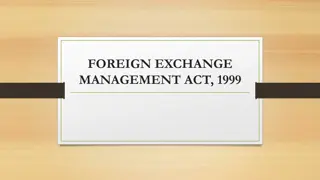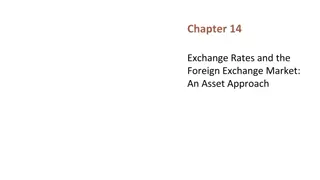Standards and Formats in Bibliographic Information Exchange
International Standard Bibliographic Description (ISBD) defines rules for creating standardized bibliographic descriptions, facilitating information retrieval in libraries. MARC 21 Format for Bibliographic Data serves as a carrier for bibliographic information across various material types. ISO 2709 is an ISO standard for bibliographic descriptions, outlining a generalized exchange format. These standards play crucial roles in organizing and exchanging bibliographic records efficiently.
Download Presentation

Please find below an Image/Link to download the presentation.
The content on the website is provided AS IS for your information and personal use only. It may not be sold, licensed, or shared on other websites without obtaining consent from the author. Download presentation by click this link. If you encounter any issues during the download, it is possible that the publisher has removed the file from their server.
E N D
Presentation Transcript
MLIS 102 Advanced Information Retrieval System (IRS) (Theory) Standard in Bibliographic Record format & Description ISBD, MARC 21, CCF, FRBR, BIB FRAME, DUBLIN CORE Standards for bibliographic information exchange and Communication: ISO 2709, Z39.50, Z39.71
ISBD, MARC 21, CCF, FRBR, Bib Frame, Dublin Core ISBD stands for International Standard Bibliographic Description. It is a set of rules produced by the International Federation of Library Associations and Institutions (IFLA) to create a bibliographic description in a standard, human-readable form, especially for use in a bibliography or a library catalog. ISBD defines nine areas of description, each consisting of multiple elements with structured classifications. ISBD also prescribes punctuation to separate and identify the elements and areas. ISBD can help users locate and access information from various sources, such as books, journals, newspapers, or digital media. ISBD can also support the exchange of bibliographic records internationally, as well as the development of national cataloging rules and systems.
The MARC 21 Format for Bibliographic Data is designed to be a carrier for bibliographic information about printed and manuscript textual materials, computer files, maps, music, continuing resources, visual materials, and mixed materials. It contains data elements for the following types of material: Books (BK) Continuing resources (CR) Computer files (CF) Maps (MP) Music (MU) Visual materials (VM) Mixed materials (MX) The format consists of a record structure, a content designation, and the data content of the record. The record structure is based on the international standard Format for Information Exchange (ISO 2709) and its American counterpart, Bibliographic Information Interchange designation is defined by the codes and conventions (tags, indicators, subfield codes, and coded values) that identify the data elements in MARC bibliographic records. The data content is usually defined by standards outside the format, such as the International Standard Bibliographic Description (ISBD), Anglo-American Cataloguing Rules, Library of Congress Subject Headings (LCSH), or other cataloging rules, subject thesauri, and classification schedules. (ANSI/NISO Z39.2). The content
ISO 2709 is an ISO (International Organization for Standardization) standard for bibliographic descriptions, titled Information and documentation Format for information exchange. It is maintained by the Technical Committee for Information and Documentation (TC 9846). It specifies the requirements for a generalized exchange format which will hold records describing all forms of material capable of bibliographic description as well as other types of records. The ISO 2709 record has four sections: record label, directory, data fields, and record separator. The record label includes the record length and the base address of the data contained in the record. The directory provides the entry positions to the fields in the record, along with the field tags. The data fields contain data and a field separator. The record separator is a single character. There are three kinds of fields in the ISO 2709 record: record identifier field, reserved fields, and bibliographic fields. The record identifier field has tag 001 and identifies the record. The reserved fields have tags in the range 002 009 and 00A 00Z and supply data for the processing of the record. The bibliographic fields have tags in the range 010 999 and 0AA ZZZ and contain data about the material described by the record. The bibliographic fields can also have optional sub-parts: indicators and identifiers. Indicators provide further information about the contents or the relationship of the field. Identifiers identify data within the field. Both indicators and identifiers are composed of a delimiter and an identifying code. The ISO 2709 standard does not define the length or the content of individual records and does not assign any meaning to tags, indicators or identifiers, these specifications being the functions of an implementation format. Some examples of implementation formats based on ISO 2709 are: MARC 21/UNIMARC/CCF (Common Communication Format).
Common Communication Format (CCF) is a standardized format for creating and exchanging bibliographic records between different information systems, such as libraries, databases, and catalogues. It was developed by UNESCO in the late 1970s and early 1980s to facilitate the interoperability and compatibility of bibliographic data. CCF is based on the ISO 2709 standard, which defines the structure and syntax of a bibliographic record. A CCF record consists of four sections: record label, directory, data fields, and record separator. The record label contains information about the record length, the base address of the data, and other indicators. The directory provides the entry positions and tags of the data fields in the record. The data fields contain the actual bibliographic data, such as author, title, publication date, etc. The record separator is a single character that marks the end of the record. The data fields in CCF are divided into three types: record identifier field, reserved fields, and bibliographic fields. The record identifier field has tag 001 and uniquely identifies the record. The reserved fields have tags from 002 to 00Z and provide data for the processing of the record, such as language, country, etc. The bibliographic fields have tags from 010 to ZZZ and provide data about the material described by the record, such as subject, abstract, notes, etc. The bibliographic fields in CCF can also have optional sub-parts: indicators and identifiers. Indicators are one or two characters that provide further information about the contents or the relationship of the field. Identifiers are composed of a delimiter and an identifying code that identify data within the field. CCF does not define the length or the content of individual records and does not assign any meaning to tags, indicators or identifiers. These specifications are determined by the implementation formats that use CCF as a basis, such as MARC 21, UNIMARC, or CCF itself.
FRBR stands for Functional Requirements for Bibliographic Records. It is a conceptual model developed by the International Federation of Library Associations and Institutions (IFLA) that relates user tasks of retrieval and access in online library catalogues and bibliographic databases from a user s perspective. It represents a more holistic approach to retrieval and access as the relationships between the entities provide links to navigate through the hierarchy of relationships. The FRBR model consists of three groups of entities: Group 1 entities are work, expression, manifestation, and item (WEMI). They represent the products of intellectual or artistic endeavor. Group 2 entities are person, family and corporate body, responsible for the custodianship of Group 1 s intellectual or artistic endeavor. Group 3 entities are subjects of Group 1 or Group 2 s intellectual endeavor, and include concepts, objects, events, and places. The FRBR model also defines four user tasks that can be performed with the bibliographic data: To find entities in a search To identify an entity as being the correct one To select an entity that suits the user s needs To obtain an entity (physical access or licensing). The FRBR model is separate from specific cataloguing standards such as Anglo-American Cataloguing Rules (AACR), Resource Description and Access (RDA) and International Standard Bibliographic Description (ISBD). However, it can be used as a basis for developing implementation formats that use the ISO 2709 standard, such as MARC 21, UNIMARC, or CCF.
BIB FRAME stands for Bibliographic Framework. It is a data model for bibliographic description that uses linked data principles to make bibliographic data more useful both within and outside the library community. BIB FRAME was designed to replace the MARC standards, which are based on outdated techniques for data management. BIB FRAME is expressed in RDF abstraction: work, instance, and item. A work reflects the conceptual essence of the resource, such as its authors, languages, and subjects. An instance represents a material embodiment of the work, such as its publisher, date, and format. An item is an actual copy of an instance, such as its location, shelf mark, and barcode. BIB FRAME also defines three additional classes that relate to the core categories: agent, subject, and event. An agent is a person, organization, or jurisdiction associated with a work or instance through roles such as author, editor, composer, etc. A subject is a concept that the work is about, such as a topic, place, event, work, instance, item, agent, etc. An event is an occurrence that may be the content of a work. BIB FRAME does not define the length or the content of individual records and does not assign any meaning to tags, indicators or identifiers. These specifications are determined by the implementation formats that use BIB FRAME as a basis. Some examples of implementation formats based on BIB FRAME are: MARC 21 UNIMARC CCF (Common Communication Format) and based on three categories of
Dublin Core is a set of fifteen main metadata items for describing digital or physical resources, such as web pages, books, images, etc. Metadata is data that provides information about other data. For example, the title, author, and date of a book are metadata that describe the book. Dublin Core was developed by an international group of professionals from different fields, such as librarianship, computer science, and museums. The name "Dublin" comes from Dublin, Ohio, USA, where the first workshop on Dublin Core was held in 1995. The word "Core" means that the metadata items are broad and generic, and can be used for a wide range of resources Dublin Core is also used as an adjective for Dublin Core metadata, which is a style of metadata that uses multiple vocabularies based on the Resource Description Framework (RDF), a generic data model for metadata.RDF allows metadata to be linked and shared platforms. Dublin Core metadata can also be customized and extended by using application profiles, which are sets of rules and guidelines for using Dublin Core with other vocabularies to meet specific needs. across different applications and
Dublin Core Element Use Possible Data Value Standards A name given to the resource. Title The topic of the resource. Library of Congress Subject Headings (LCSH) Faceted Application of Subject Terminology (FAST) Art & Architecture Thesaurus (AAT) Subject An account of the resource. Description An entity primarily responsible for making the resource. Library of Congress Name Authority File (LCNAF) Faceted Application of Subject Terminology (FAST) Creator An entity responsible for making the resource available. Publisher An entity responsible for making contributions to the resource. Library of Congress Name Authority File (LCNAF) Faceted Application of Subject Terminology (FAST) Contributor A point or period of time associated with an event in the lifecycle of the resource. W3CDTF Date The nature or genre of the resource. DCMI Type Vocabulary Type The file format, physical medium, or dimensions of the resource. Internet Media Types (MIME) Library of Congress Genre/Form Terms (LCGFT) Thesaurus for Graphical Materials (TGM) Format An unambiguous reference to the resource within a given context. Identifier A related resource from which the described resource is derived. Source A language of the resource. ISO 639 Language A related resource. Relation The spatial or temporal topic of the resource, the spatial applicability of the resource, or the jurisdiction under which the resource is relevant. Thesaurus of Geographic Names (TGN) Geonames Coverage Information about rights held in and over the resource. RightsStatements.org Rights
At its most basic, Z39.50 is a communications protocol that enables two systems to exchange messages for the purpose information retrieval. It is a computer-to-computer protocol that enables intersystem communication for the purpose of searching and retrieving information.
Z39.71 is an International Standard Protocol used by networked computer systems for information retrieval. It enables information seekers to search different systems on a network or the Internet through the use of a single user interface. Nine principles of Z39.71 Z39.71 lays out nine principles, or major concepts, that holding records need to adhere to. Levels of Specificity. There are four levels of specificity, ranging from a simple statement that the library holds the item on up to a complex, detailed statement of exactly what parts of the item are held. ANSI/NISO is discussing adding a fifth level that would include a barcode. See Table 1: Levels of Specificity for examples. Identification of Data Elements. Data Elements are identified, or set off from each other, by punctuation. Punctuation is prescribed within two Data Areas (the General Holdings Area, and the Extent of Holdings Area), but does not need to be consistent from Data Area to Data Area. See Table 2: Punctuation for punctuation definitions. Optional Data Area or Element. The standard designates each Data Area, and each Data Element, as being mandatory, not used, or optional in a holdings record. This may vary with the Level of Specificity of the holdings record, in that a Data Area may be optional for one level but required for another level. Pieces Held. For Level 1 - 3 holdings statements, the standard focuses on the parts of the item that are held, rather than those parts that are not held. Gaps can optionally be recorded in the Holdings Note Area. Number of Locations and Copies. If a library holds multiple copies in multiple locations, it has two options: Create multiple holdings records, one for each copy or location. Create one holding record (a "composite" record) reflecting the multiple copies or locations. Form. Holdings my be recorded in either compressed or itemized form. Additionally, the same holdings record could have both compressed and itemized holdings information. Cataloging System. The holdings standard is independent of a cataloging system or code. When Z39.71 conflicts with AACR2, use Z39.71. Put another way, AACR2 is for bibliographic records, and Z39.71 is for holdings records. Relationship of Holdings Statement to Bibliographic Item. The holdings record will link to only one bibliographic record. However, the bibliographic record itself may reflect multiple items (e.g., a series, supplements). Formats. If a library holds multiple versions of the same item (e.g., it holds both the paper and microfiche for Time magazine), it has a few options for how many holdings records to create, and which bibliographic record or records to link to.
Z39.71 Data areas & data elements There are six Data Areas, or fields. A Data Area can sometimes be further subdivided into multiple subfields. These are officially referred to as Data Elements. The order of the Data Areas is not specified by the standard. However, within each Data Area, the order of the Data Elements is prescribed. The six Data Areas are: Item Identification Area. This is the link from the holdings record to the bibliographic record; it identifies the bibliographic record the holdings record should be attached to. The actual link (technically referred to as the identifier) can vary: ISSN, ISBN, OCLC record number, etc. It can even be a partial bibliographic description. Location Data Area. Identifies the exact location of the item. It can be in free text, although some systems mandate specific formats. It has four Data Elements: the library code, the branch or sublocation, copy number, and call number. Date of Report Area. The date the holdings record was created or updated. It is recorded in YYYYMMDD format. An unknown date is recorded as 00000000. General Holdings Area. Contains general holdings information, such as whether an item is a book or a DVD. This is subdivided into five Data Elements, and each element has a series of coded values. Systems typically convert the coded values into full-text for OPAC displays: Type of Unit: Is it a volume, a supplement, or an index? Physical Form Designator: Is it a hardback, a paperback, or an ebook? Completeness Designator: If it's a serial, how much of the serial do you hold? Acquisition Status Designator: Is it on order, currently acquired, or ceased publication? Retention Designator: The library's retention policy. Is the item retained until replaced by microfilm? Or permanently kept? Extent of Holdings Area. For serial publications, this field contains specific holdings information about the range of volumes held by the library. It consists of five Data Elements: Name of Unit: Is it a volume, an issue, a bund, or a tome? Extent of Unit: How many parts does the item have? Enumeration: The actual number of the volume. Chronology: The date on the volume. Specific Extent Note: Information clarifying the contents of any of the other Data Elements (e.g., bound, unbound). Holdings Note Area. Free-text note field relating to the holdings (not the bibliographic record). Examples of notes include whether or not the item circulates, or its physical condition.
Definition Z39.50 ANSI/NISO Z39.50 is a protocol which specifies data structures and interchange rules that allow a client machine (as called an origin in the standard) to search databases on a server machine (called a target in the standard) and retrieve records that are identified as a result of such a search.
